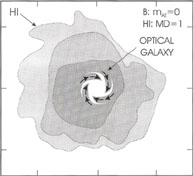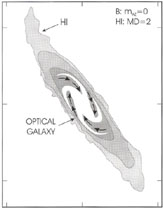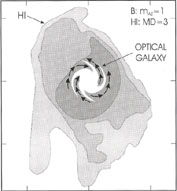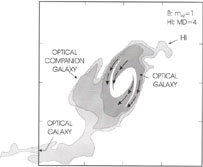


4.4.2. B shapes and HI shapes - companions or bars
The second type of magnetism (spiral/bisymmetric) also occurs more frequently when there are strong effects from a close companion galaxy, or from a strong oval bar in the galactic nucleus (Vallée, 1988a). These results do not support the theory of a weak intergalactic magnetic field being amplified into a BSS shape by a large amount through gravitational contraction of a protogalaxy to give rise to the observed magnetic field strengths - rather, a leakage of galactic magnetic fields into the intergalactic space may be occurring.
The influence of the environment on the HI content of spiral galaxies has been reviewed previously (e.g., Haynes et al. 1984). The HI flux and distribution can be used to diagnose past dynamical traumas. Neutral hydrogen has proven to be a better tracer of past tidal disruption than does starlight data. Past descriptions of HI distributions have been morphological but loosely defined (e.g., "symmetric", "warped", "exhibiting appendages", "with an envelope", etc.). Such a morphological approach may appear somewhat mysterious to a physically oriented reader. Hence there was a need to order each morphology along a physical sequence.
A recent attempt has been made to set up a more rigorous morphological classification of HI distributions, ordered along a physical sequence of greater and greater complexities (Vallée, 1993c; Vallée, 1994a; Vallée, 1995b), based on four basic HI shapes in spiral galaxies, which are summarised briefly here:
 2 kpc.
2 kpc.
 2 kpc.
Examples are warps, bumps, or spiral features at a larger pitch
angle than that of the optical spiral arms.
2 kpc.
Examples are warps, bumps, or spiral features at a larger pitch
angle than that of the optical spiral arms.
 2
kpc. Examples are inverted S-shaped HI
features (opposite to the S-shaped form of the inner optical stellar
arms), or else spiral features at a much larger pitch
angle (> 20°) than that of the optical spiral arms.
2
kpc. Examples are inverted S-shaped HI
features (opposite to the S-shaped form of the inner optical stellar
arms), or else spiral features at a much larger pitch
angle (> 20°) than that of the optical spiral arms.
 2
kpc. Examples are spiral features at a
much larger pitch angle (> 20°)
than that of the optical spiral arms. This resembles MD = 3 except
for the much larger distance involved.
2
kpc. Examples are spiral features at a
much larger pitch angle (> 20°)
than that of the optical spiral arms. This resembles MD = 3 except
for the much larger distance involved.Vallée (1993c) investigated the neutral hydrogen distributions (HI shapes) in 6 nearby spiral galaxies with known magnetism (M51, M63, M83, M106, NGC253, NGC2903). This was the first statistical evidence that a spiral galaxy with an apparently undisturbed (i.e., regularly shaped or slightly affected) HI shape seems to possess an axisymmetric magnetic field mazim = 0, and that a spiral galaxy with a significantly disturbed (ie strongly arched or extremely perturbed) HI shape seems to possess a bisymmetric magnetic field mazim = 1 .
Vallée (1994a) pursued this matter, in 6 other spiral galaxies with a known magnetism (M31, M33, M81, IC342, NGC6946 and Milky Way), and found the same correlation between HI shape and magnetism: disturbed HI and mazim = 1; undisturbed HI and mazim = 0.
Figure 15 shows a sketch of four spiral galaxies with different HI distribution, from MD = 1 to MD = 4, to show how the HI shape (MD low to high) goes with the magnetism (mazim low to high).
 |
 |
 |
 |
Figure 15. Model linking galactic dynamics with galactic dynamos. One sketch is shown of an optical galaxy with spiral arms (at center, in white), for each of the various MD shape for the HI gas (HI gas density in increasing shades of grey). The magnetic field directions are shown (arrows). (a) A simple undisturbed HI gas shape MD = 1, with azimuthal ASS magnetic field B shape being mazim = 0. (b) A HI gas shape MD = 2, with B shape mazim = 0. (c) A disturbed HI gas shape MD = 3, with a complex azimuthal BSS magnetic field B shape mazim = 1. (d) A complex HI gas shape MD = 4, with B shape mazim = 1. See Vallée (1997) for more details. |
|
Vallée (1995b) pursued the relationship between galactic dynamos and galactic dynamics, as evidenced by a link between the magnetic field shape and the neutral hydrogen shape, for 3 other galaxies (NGC891, NGC4631, and the LMC).
Thus the current list of 16 spiral galaxies with both observed mazim and observed MD values are:
All of these galaxies have a preliminary or definite mazim value; in some cases, there is a predominant mazim value and a weaker secondary mazim value, like a predominant mazim = 0 and a secondary mazim = 2 value in NGC6946 (e.g., Beck and Hoernes 1996).
Higher azimuthal Fourier modes mazim could be expected by dynamo theory to be superimposed on the dominant lower mode, but these should have relatively small amplitudes (e.g., Beck et al. 1996).
Figure 16 shows the preliminary statistical link between HI shape and magnetic field shape. Only discrete numerical values can be observed in this Figure (mazim = 0, 1, 2, ...; MD = 1, 2, 3, 4, ...) but the non-random locations of the data show a definite trend (bottom-left to top-right), suggesting that an increase in complexity in B goes along with an increase of complexity in HI. The statistical link points to a necessary common cause for creating complex HI fossils and complex magnetic field shapes.
 |
Figure 16. Plot of the observed HI gas shapes (MD parameter, on x-axis) versus the observed magnetic field shapes (mazim parameter, on y-axis) for 16 nearby galaxies with spiral structures (circled crosses, some shifted slightly to avoid overcrowding). Only discrete values of the parameters can be observed (mazim = 0, 1, 2, ...; MD = 1, 2, 3, 4, ...), but the non-random locations of the data show a preliminary trend (bottom-left to top-right) as sketched by the broad line, implying that a more complex HI shape goes along with a more complex magnetic field configuration, while a simple HI shape goes along with a simple magnetic configuration. See Vallée (1995b) for more details. |
In dealing with statistics of 'quantized' parameters (the MD classes use positive integer values; the mazim classes use integer values and zero), then some minimum non-zero scatter is unavoidable even in a perfect relationship - much like the attempt to fit a straight linear diagonal to an ideal staircase.
Physical link. The most likely common cause would be a deformed gravitational potential around a spiral galaxy. Possible origins of such disturbances could be a tidal deformation caused by the passage of a nearby companion galaxy (e.g., NGC5086 is near NGC2903 and there is a large bar in NGC2903 as well as sizeable HI distortions; NGC5195 is very near M51 which has extreme HI distortions; M31 is near M33, and M33 has infalling HI companions and sizeable HI distortions; NGC3077 is very near M81 which has extreme HI distortions). It could also be caused by a large barred oval nucleus (e.g., M83 - see Zweibel 1991). Hummel & Beck (1995) also concur that NGC2276, in gravitational interaction with NGC 2300, has a severely distorted shape and a non-axisymmetric magnetic field shape. Limited RM data on NGC 1566 (Ehle et al., 1996) and on NGC4254 (Soida et al., 1996) await further study.
The presence of a deformation of the galactic gravitational potential implies the concept of dynamical time scale, and the possibility that when the disturbing agent goes away, then the galactic system may revert to a more quiescent state.
On the theoretical side, Moss (1995) and Moss (1996b) have laid down the first equations pertinent to the generation of BSS magnetic field shape in a spiral galaxy, due to a tidal interaction by a companion galaxy.